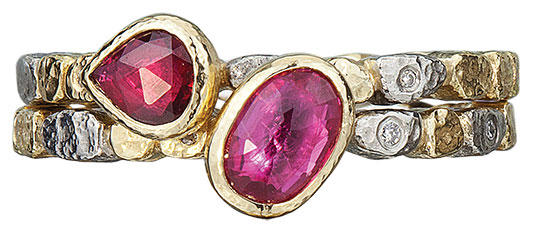|
|
Cover

Retail Rap
By Phyllis Schiller
 | | Rona Fisher |
The 4Cs are not the only things that make a piece of diamond jewelry a sales winner. In an ongoing series, Rapaport Magazine explores the “3Ws” — what’s selling, what’s not and why — by going straight to the people who really know — jewelry retailers. Each month, we ask a sampling of retailers to comment on the important issues that are facing the industry today. Here is what they had to say when asked: “Which gemstones are most popular? Do you need to educate your customers more about colored gemstones than with diamonds?” “Color gemstone sales are steady but nothing that would rival diamond sales. While we have sold the big three gemstones — sapphire, ruby and emerald — and some significant pieces, we also do some more exotic stuff. Spinel is probably one of our best-selling colored stones, just because it’s unusual and the color is typically more natural and it’s durable. In fashion jewelry, colored gemstones are increasingly a bigger part of what we sell, especially with the silver manufacturers. “It is far more of an educational process in selling colored stones. Customers typically come in armed with some knowledge of at least the 4Cs of diamonds. Explaining about treatments has to be part of the repertoire so they understand the reality behind the colored stones they are buying and that most gems are treated. With colored stones, we’re usually creating the passion for that particular gem, showing them how special it is and that it typically came out of the ground the color they’re seeing, which is why we do well with some of the more exotic stones.” “What sells primarily are the big three, sales are split pretty evenly among them. Next after sapphire, ruby and emerald is blue topaz or morganite. With the big three gemstones, it’s more fashion styles, but beyond that, for blue topaz, amethyst, peridot and so forth, it’s more basic styles that sell. “I don’t think much education is needed to sell colored stones, except concerning wearability and durability. We do explain treatments to customers but it doesn’t affect whether they’re going to purchase the piece or not.” “We sold across the board this past Christmas, diamond semimounts, engagement rings and colored stones both in silver and in white gold and yellow gold. I would say, if you combine the silver and the gold, colored gemstones were a good fifth of our business. As far as volume goes, we probably sold more of citrine, blue topaz, pearl, which we put in that category, garnet and amethyst than the big three stones. We do explain that most colored stones are treated in one way or another. We go into it as deeply as the customer wants to, but it’s usually not a big issue. Colored gemstones are less of a commodity than a diamond is with certificates and the internet. We sell it more based on color and romance; it’s definitely more fun.” “In terms of color, based on the past six months, for us, sapphire is still probably number one. This year, tanzanite was second in line. A lot of people’s reference to color is their birthstone or because it’s a favorite color. With a little more education, you can develop their appreciation for other things about gemstones. I think customers have a surface level understanding about treatments. We try to educate our customers on everything, whether it’s diamonds or color.” “We love colored stones; we started with colored stones. But in order to grow our business, we had to get into the bridal business. Diamonds are always the thing that brings people in and the thing that people want. And in theory, if you can secure them as clients, then they continue to grow with you. Color for us is a lot more fun, a lot more creative. This past December, we sold more higher-end emerald, ruby and sapphire pieces than I have probably sold in the past five years. By the same token, I had a couple of larger diamond sales from existing clients. There’s education involved no matter what you sell and talking about treatments is a natural part of the discussion. “My biggest collectors of colored gemstones are working women between the ages of 30 and 60. They interchange their wardrobe of jewelry along with their clothes and shoes and handbags. They’ve got the disposable income to buy a really special pink sapphire ring and then some matching diamond earrings or a really interesting African tourmaline ring because it’s beautiful. But without disposable income, clients will limit themselves to just diamond pieces. They won’t always be able to reach for that green African tourmaline because it doesn’t go with everything. It takes a really specific woman to wear interesting colored stones.” “I really love the colored gem department in my store. And I have a collection with nothing below first class; I have no synthetics. I’m very proud of our colored stones and we do quite well with them. Sapphire would be the predominant stone because it goes better with everything else and of the big three stones, it’s the least expensive, which might have some bearing on it. Of course, there’s a lot of explanation that this is not a conflict stone and this is not a treated stone except perhaps with heating — because almost all colored stones are heated to enhance the color, that’s almost a given. But rather than going through the 4Cs, like you do with a diamond, it’s fun to get into the history, the folklore, the superstitions and all of that stuff about colored gemstones.”Article from the Rapaport Magazine - February 2016. To subscribe click here.
|
|

|
|